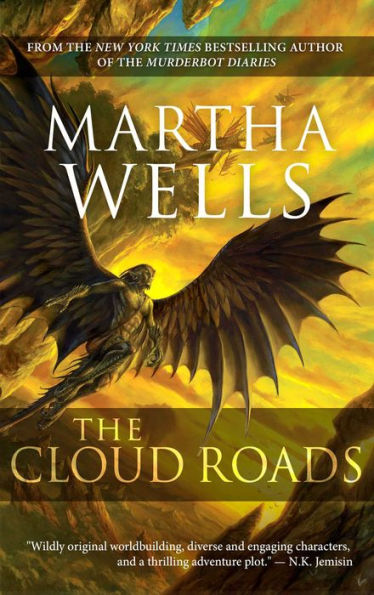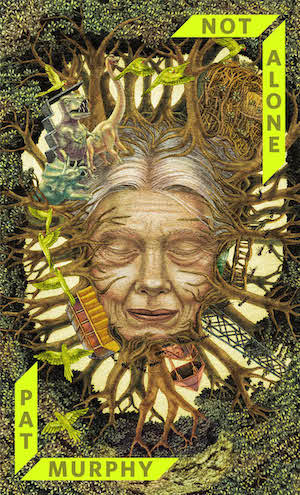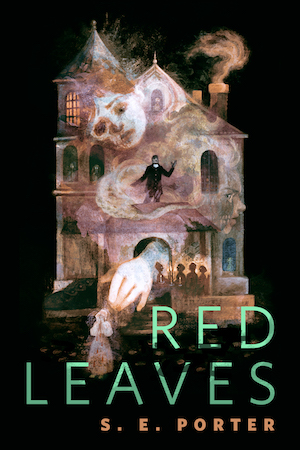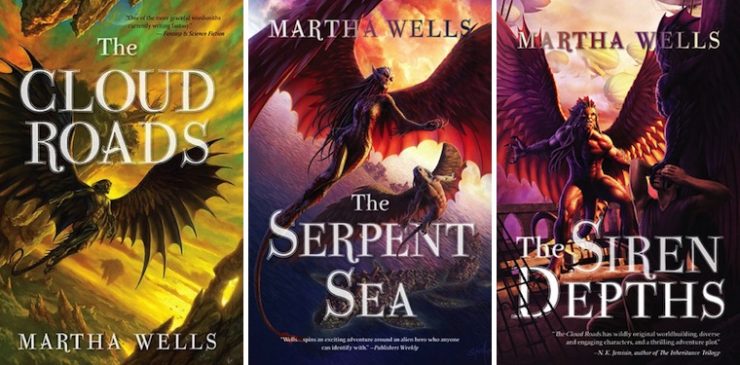I’ve been thinking a lot about comfort reading lately. I know I’m not alone in this. We are, after all, in the middle of a socially isolating global pandemic with no end in sight, and we spend too much of each day worrying about everything from the health of our loved ones to the fragility of our institutions. The uncertainties of daily life have been compounding for a good long while. The value of a comfort read lies in its familiarity, in the way sinking into its pages removes some of that uncertainty from our increasingly frightening lives. It can feel like inviting old friends over for a party, even though we are all definitely avoiding parties at this particular moment…
The stories I have been returning to for comfort over the past few years are Martha Wells’ Books of the Raksura. The series begins with The Clouds Roads and contains five novels, two collections, and a bunch of shorts posted on Wells’ Patreon. Until recently, I had never given much thought to why these books are my go-to comfort read, mostly because they feel, on one level, like the very definition of escapist literature. They are about a cast of non-human shapeshifting winged predators in a world that looks nothing like our world, offers none of the usual cultural analogues, and builds character relationships within unique social structures. The stories are also fun, adventurous, and wildly imaginative. Every reread is like taking a vacation into the most gloriously impossible locations, where the locals are diverse and interesting, the geography includes floating islands and trees that house entire cities, and a lot of things want to eat you…all very good ways to escape the real world for a while!
But lately I’ve been thinking there’s more to it than that. I certainly don’t believe that there’s anything at all wrong with seeking pure escapism in your reading and other media. (Example: When the world gets especially rough, I sometimes pass an evening helping a friend search for Korok seeds in Breath of the Wild, an activity which requires no effort and has absolutely no stakes.) But there is value in considering why certain stories comfort us during times of fear and uncertainty. We are getting something from those stories, whatever form they take, and I want to think about what that something might be and why it is so important.
Buy the Book


The Cloud Roads
When we first meet Moon, the main character of the Raksura series, he is lying to everybody he knows. He’s lying to the villagers he lives and works alongside. He’s lying to the women who share his home and his bed. And he’s lying to himself. He’s lying to himself about what he desires, how he wants to live, what he would like his future to look like, what makes for a satisfying and contented life. He’s lying about how desperately lonely he is. He’s been lying to himself for so long he doesn’t even recognize it anymore. He calls it coping. He calls it acceptance.
As a story opener, this is catnip to me. It was when I first read The Cloud Roads, and it remains so now that I’ve read the entire series multiple times. It takes only a few pages before I’m thinking, “Well, okay, I’m in the mind of a magical scaly flying lad who talks about his wings and disemboweling claws the same way we talk about our legs and hands. Awesome. Let’s go with it.”
It is a testament to Wells’ clarity of writing and skill with world-building that none of this is confusing or alienating, but it also works because of the shape of the story itself. At the beginning of the series, not only do we have no idea what Moon is, but he has no idea himself. The only family he ever knew was killed when he was very young, and he’s never met anybody like himself in thirty-some years of wandering his big, strange world. The one and only time he has tried to find people like him taught him that there are other kinds of scaly shapeshifting winged predators out there, and they’re awful, and everybody will try to murder him if they discover he’s similar to that.
That’s where the lying to everybody he knows comes into it. He lies to protect himself in the most fundamental sense: he doesn’t want everybody he meets to try to kill him.
But that’s also where the lying to himself comes in. Moon has given up on being able to trust anybody. Ever. He thinks of it as a wholly practical approach to life. They’ll hate him if they find out what he is, so they can’t find out. It’s that simple. He tells himself he’s fine with that. (Narrator: He is not fine with that.)
Then two things happen in quick succession that upend the entire lonely, careful, secretive life Moon has been living.
First: His worst fear comes true. The people he’s living find out he’s not like them, and they try to kill him. He’s not particularly surprised; this is what he’s spent his entire life waiting for every time he’s tried to make a home.
Second: Somebody saves him. Somebody who knows what exactly what he is. A stranger who is the same kind of scaly winged magical shapeshifting predator as Moon. His name is Stone, he calls what they are “Raksura” and, hey, he wants Moon to come with him to meet a whole society of others like them.
This is all set up in the first two chapters—I’m not spoiling you. (Go read the series so you stop worrying about spoilers, and because it’s so good! But I’m not spoiling you.) What I’m describing is the premise, the story that happens before the story. It’s not an info-dump; we certainly don’t understand everything from the start. Just go with it. It’s remarkably easy to be carried along for the ride as the cast and world grow in delightful and unexpected ways. Wells is frequently and rightfully praised for her breathtaking worldbuilding, but I’m going to save a discussion of the world for another essay. There is quite a lot of it, and I want to give it its due.
For now, I just want to explore the richly emotional story woven into that weird and wonderful world. I mean, look, I’m not going to lie. I just want to talk about Moon and his feelings. Because the more I think about it, the more convinced I am that the imaginative, unabashed alienness of the Raksura characters and world is what makes it possible for the emotional arc of the story to wriggle its way under the skin so easily. My theory is that the very fact that they are nothing like me is why they provide so much lasting comfort.
Let me back up a little to provide some context…
Lonely heroes in search of connection and understanding are all over all literature, especially science fiction and fantasy, and there’s a good reason for that. There are quite a lot of good reasons, in fact, including the reality that it’s just plain fun to stick a loner into a variety of situations that require them to connect with, trust, and maybe even kinda sorta like other people. It works in everything from Artemis Fowl to Mad Max: Fury Road. We want the ragtag group of outcasts to find each other. We want the shy wallflower to make friends. We want the tragic warrior to reveal a bit of themselves to an unlikely ally. We want the samurai space bounty hunter to adopt the tiny baby alien.
These kinds of stories get their hooks into us because the act of engaging with a story is, in its own way, a choice to seek connection. Sometimes what we want is a gentle and amusing diversion to take our minds off the real world for a while. Sometimes we want something deeper and lasting, an experience that will continue to shape our perspective for years to come. Most of the time we don’t know what we want and don’t even think of it in terms of wanting anything beyond a good story to enjoy. And that’s fine! The most powerful stories are often the ones that give us things we don’t even know we’re looking for.
It is also true, however, that many of these stories about finding family, home, and connection tend to fall into well-worn story paths.
The tiresome trope about the tough man being softened by the love of a good woman may inspire a lot more eye-rolling these days, but it’s still extremely common in all forms of media. More and more stories may be turning away from adherence to traditional family structure as the ultimate goal and toward more variable found families, but quite a lot of them still somehow end up with a male head-of-family as their leader. More stories, especially in SFF, are now acknowledging non-heteronormative romantic relationships, but even those diverse stories still frequently accept it as given that the natural end goal is for everybody to be paired up two-by-two in exclusive, sexual relationships. There are a depressingly large number of stories out there, in every genre and medium and age group, in which the only legitimate roles for female characters are still primarily caregivers and nurturers.
Each of these well-worn story paths rely on a lot of assumptions about the structure of a family, about the nature of friendship and romance, about gender roles within families and societies, about who is expected to provide nurturing and who deserves to receive it, about what it means to find a family, about how you’re supposed to change when you do.
It is very easy to become inured to such patterns in literature and other media when they also make up the fabric of the world we live in. It is very easy to internalize those patterns without question. Sometimes we don’t even know we’re so comfortable with them until we read something that takes everything we’ve been assuming about how people connect to each other and transforms it into something that feels both natural and new.
So let’s get back to the scaly winged shapeshifter predator people and their feelings.
One of the reasons I revisit the Raksura series over and over again is that the unusual nature of the characters and their world allows freedom from many common assumptions and tropes about how people connect to one another. For example, the Raksura, as a culture, are agrarian, communal hunters with no concept of commerce or currency and divisions of labor that do not map onto any kind of class division; the people who tend the crops are as important as the people who raise the children, and both are as important as the warriors who protect the community. They are matriarchal, polyamorous, and pansexual, and have very few taboos relating to sex or intimate relationships. So right from the start a whole lot of the hang-ups that drive human-centered stories of connection are turned on their heads. On the other hand, Raksura society is rigid in other ways, with leaders defined by their biology, its own confining gender dynamics, almost no mobility between social roles with the community, elaborate rules and manners for official interactions, and the lives of entire populations often depending on the whims of temperamental queens who will literally fight each other to the death to assert power.
Nothing is smooth or easy or simple, and watching the characters find out how they fit together is all the more satisfying for it. The first people Moon meets of his own species are a community on the verge of collapse; they are suffering from a number of external and internal traumas that started long before he came along. They aren’t in agreement about what to do to protect themselves; they aren’t in agreement about whether they want somebody new hanging around; they aren’t even in agreement about how to survive.
Moon may have found a home, the beginnings of a family, several friendships and relationships, and a community that takes care of its members, but a lifetime of trauma and loneliness can’t be overcome overnight. Moon’s years alone may have taught him how to survive tough situations, but those years have also given him some really, really deeply unhealthy coping mechanisms. He’s distrustful of everyone and everything, constantly terrified of making a mistake that will get him killed, frequently lies when honesty would serve him better, never expects people to treat him well, doesn’t ask questions when a simple answer would solve a lot of problems, and tends to assume that everybody is assuming the worst about him at any given time.
There is nothing ennobling or dignified about the trauma Moon has suffered. It has fucked him up in ways he has to deal with even when things are going well.
And while it would take an entire thesis to get into all of the details, this is also true of the other characters in the series. Their experiences might have made them better at fighting monsters who want to eat them, but a lifetime of fighting for one’s life doesn’t make a person better at all the non-fighting parts of living. There is a queen whose inability to protect her people has caused her to sink into a deep depression and another who is still fighting battles she won at great cost decades ago. There are young people who are war orphans of both allies and enemies now trying to find out where they fit in the world. There are a lot of people who simply don’t like each other for reasons both petty and serious. There are characters who are despondent, others who are clearly suffering from PTSD, quite a few who are desperate for change but afraid to push for it, and some who are just so lost and angry it overpowers everything else in their lives.
There are not characters whose jagged edges are neatly filed off by the right combination of friendship and found family, because this is not a story interested in easy solutions to complex problems. The world they live in, with all its violence, sickness, distrust, betrayal, doubt, and people who want to eat them, has done a number on everyone, but they still learn to make decisions, get along, change, grow, disagree, and compromise on every level, from private, interpersonal relationships between individuals to political relationships between large populations who don’t like each other and don’t want cooperate.
And that, I think, is the true reason I find this series so comforting in times of unending fear and uncertainty. I love a lot of stories in which the right friendship, relationship, family, or ragtag group of outcasts can provide what a lonely character needs to be happy—but it’s hard to get past the fact that I’m always aware that it isn’t really enough. What good are heroism, romance, and grand battles against terrible enemies if there is nobody to grow the food or teach the children or unplug the drains? A lovely aspect of the Raksura series is that the people engaging in those former dramatic storylines are also the people taking care of the latter mundane tasks.
Moon’s story, over the course of the entire series, is not only the story of a young man finding a family and a home, but of learning what it means to be part of a communal society that exists in a complex, diverse world. He begins at a place of one-man-against-the-world, but over the course of the series he becomes part of a world he could only ever glimpse from the outside before. It’s a story that acknowledges that we all need friendships and family, we need personal safety and emotional healing, we need safety and home and love—but we also need something more than that. We need community. We need to take care of each other, not only on the individual scale, but on the scale of how we structure our entire societies. And we need to do it even when it isn’t easy or convenient or safe.
Kali Wallace studied geology and earned a PhD in geophysics before she realized she enjoyed inventing imaginary worlds more than she liked researching the real one. She is the author of science fiction, fantasy, and horror novels for children, teens, and adults. Her most recent novel is the science fiction thriller Salvation Day. Her short fiction has appeared in Clarkesworld, F&SF, Asimov’s, Tor.com, and other speculative fiction magazines. After spending most of her life in Colorado, she now lives in southern California.










